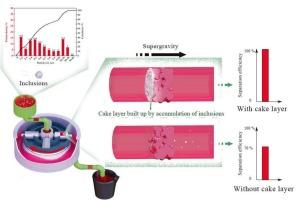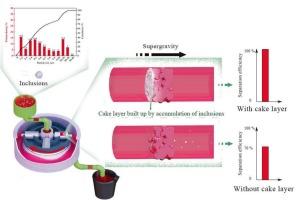Supergravity-induced continuous filtration for removing fine inclusions from molten metals
IF 4.3
2区 工程技术
Q2 ENGINEERING, CHEMICAL
引用次数: 0
Abstract
The removing of fine inclusions in molten metals plays a significant role on improving quality of metal materials. In this work, the interception behavior of Al2O3 ceramic foam filter (Al2O3 CFF) for fine inclusions in molten metals under supergravity field was accessed through both molten metal filtration and water simulation. The analysis via response surface methodology (RSM) in water simulation presented that mere filtration in deep bed of Al2O3 CFF can not trap the inclusions completely, and the increase in liquid volume elevates the separation efficiency. Combined with molten metal filtration of primary aluminum and galvanized zinc, the observation showed that the aggregation between particles and intermetallics and the cake layer wrap for inclusions on the surface of Al2O3 CFF both extremely promote the separation efficiency. The inclusion particles below 20 μm in molten metals was almost removed completely by using Al2O3 CFF of H = 20 mm and P = 130 ppi or 170 ppi under supergravity field.


从熔融金属中去除细小夹杂物的超重力诱导连续过滤
金属液中细小夹杂物的去除对提高金属材料的质量有着重要的作用。本文研究了Al2O3陶瓷泡沫过滤器(Al2O3 CFF)在超重力场作用下对熔融金属中细小夹杂物的拦截行为。水模拟中响应面法(RSM)分析表明,Al2O3 CFF的深层过滤不能完全截留包裹体,增大液体积可提高分离效率。结合原铝和镀锌锌的熔融金属过滤,观察到Al2O3 CFF表面颗粒与金属间化合物的聚集以及夹杂物的饼层包裹都极大地促进了分离效率。在超重力场作用下,H = 20 mm, P = 130 ppi或170 ppi的Al2O3 CFF几乎完全去除金属液中20 μm以下的夹杂颗粒。
本文章由计算机程序翻译,如有差异,请以英文原文为准。
求助全文
约1分钟内获得全文
求助全文
来源期刊

Chemical Engineering Science
工程技术-工程:化工
CiteScore
7.50
自引率
8.50%
发文量
1025
审稿时长
50 days
期刊介绍:
Chemical engineering enables the transformation of natural resources and energy into useful products for society. It draws on and applies natural sciences, mathematics and economics, and has developed fundamental engineering science that underpins the discipline.
Chemical Engineering Science (CES) has been publishing papers on the fundamentals of chemical engineering since 1951. CES is the platform where the most significant advances in the discipline have ever since been published. Chemical Engineering Science has accompanied and sustained chemical engineering through its development into the vibrant and broad scientific discipline it is today.
 求助内容:
求助内容: 应助结果提醒方式:
应助结果提醒方式:


